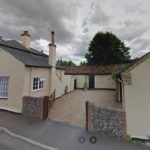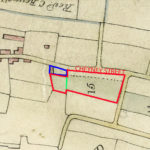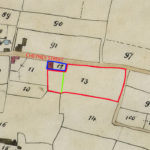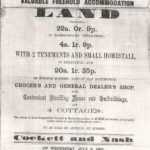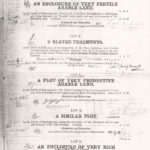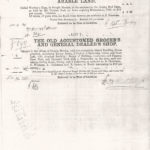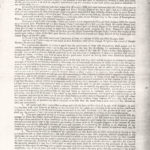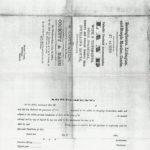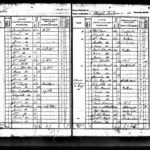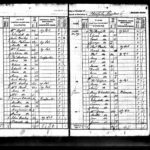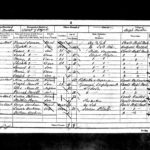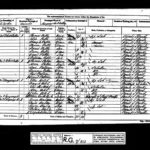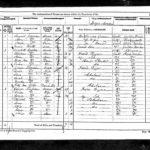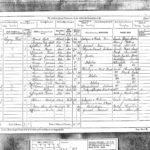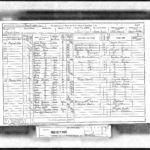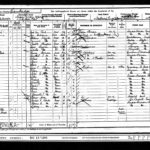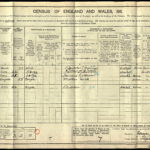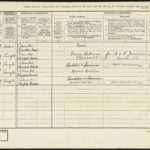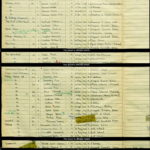24 Cheyney Street, Hill House
This house, with shop attached (lean to on side of house), was built about 1847 for Ann Newell, previously of The Hoops on The Green. Its history is inextricably linked with that of No 22 the adjoining cottage.
The tale begins around 1780, when Joseph Wright, a shoemaker, somehow acquired a modest area of garden ground (a mere 17p), carved out of a small ancient enclosure or perhaps roadside waste owned by the Earl of Hardwicke and which was copyhold of Steeple Morden Manor. Later, in the course of Enclosure 1808-1817 the remainder of the small ancient close was merged with the adjoining close and the whole was known as Cook’s Close. At the Wimpole Estate Sale in 1892, Cook’s Close was bought, along with The Bell Inn, by P & A H Meyer brewers of Orwell. Much later Cook’s Close became the site of new housing – Cheyney Close
Returning to Joseph Wright, he had a small cottage built on the land he had acquired and lived there with his wife Mary nee Burr. Mary died 1812 and Joseph 1836. Their son Joseph, also a shoemaker, lived there with wife Susan nee Bonnett. Joseph died in 1841 and Susan moved out, possibly about 1846, dying some years later elsewhere in the village, in 1863.
Ann Newell and Henry Routledge
It is difficult to be certain of the exact sequencing, although it appears that Ann Newell, widow of John, who had been tenant of The Hoops PH on The Green, bought, probably in 1846, the cottage and its garden land. She had this house with a shop built on the garden land, directly on the highway facing onto Cheyney Street. Today this is No 24, Hill House. The cottage remained still standing. Ann Newell ran quite a substantial grocery shop, which had a beerhouse licence and in the 1851 Census she is described as victualler and shopkeeper. She died 1854 and the property was bought as an investment by Henry Routledge, a particularly successful grocer & draper of Baldock.
At the time of the 1861 Census the tenant was Ellis Hitch, who gave his occupation as ag lab and only as an afterthought added “& grocer”. The curate of Steeple Morden appears to have been lodging with him at this time. It has not been ascertained how long Ellis was here as tenant, although it was potentially from 1854 to 1864. Following the death of Henry Routledge in 1863 the house with shop and the original cottage – now four tenements – were sold at auction as Lot 7 at his Estate Sale in 1864 and bought by his son Henry Routledge junior. When he in turn died in 1878 the house with shop and cottages passed to his sister Miss Arlette Routledge, who held the property until 1908 when she sold to the tenant Lewis Jarman, who remained the owner until his own death in 1958. Lewis had sold the adjoining cottages in 1948 to Eleanor Jane Lee.
It is likely that buildings for livestock etc were erected during the tenancy of Ellis Hitch. In the 1864 sale particulars the property is described:
“THE OLD ACCUSTOMED GROCER’S AND GENERAL DEALER’S SHOP, situate in the village of Steeple Morden, with the convenient Slated Dwelling House attached, containing Living Room, 2 Parlors, 5 Bedrooms, Cellar, and Store Loft, with detached Scullery, Range of Stabling, Cowhouse, and Piggery, Open Shed, and Enclosed Yard, with 4 Tenements, on the west, each containing Living Room, Pantry, and 2 Bedrooms – now held by Mr Samuel Jarman”.
Jarmans the Butchers 1864?-1958
The Jarman family came on the scene in 1861-64, when Samuel Jarman (1817-1888) born Guilden Morden, moved here as tenant from The Little Wonder beerhouse at North Brook End, where his main occupation was butcher and grocer and he continued on similar lines at No 24, where he is recorded in the 1871 Census. His son Thomas (1848-1926) had taken over the tenancy by the 1881 Census and described himself as simply grocer. He had spent time living in London and returned to take over the family business.
He was followed by his older brother Samuel (1840-1899), recorded in the 1891 Census as cattle dealer and farmer. He had four working age sons at the time and the occupation for each was given as farmer’s son. No mention of butchery, although it can be assumed that it continued. Samuel’s widow Emma (1841-1929) was head of the household in the 1901 Census and her occupation is butcher, as is her son Samuel and son Alfred is a butcher and dealer. The dealing would have been in livestock, giving the family history and location.
Emma is still in charge in the 1911 Census and is described as a purveyor of meat and butcher business. Son Edward is an ag lab, Alfred a farmer and pig dealer and Lewis a butcher. Age 80, Emma still ruled the roost in the 1921 Census, with son Edward a farm lab, Alfred butcher and Lewis smallholder. Emma died in 1929 and in 1939 the residents are Samuel E (Edward?) farm lab, Alfred farmer and Lewis farmer. Lewis described himself as a retired butcher in 1955. The Jarmans stayed here until 1959, when the property was sold after Lewis’ death the previous year.
Private House
In 1959 the property was bought by Edward J Tink and Olive C Tink nee West and for a few years Olive’s parents Oliver B West and Rosetta E West lived with them. From 1964 Olive is recorded as sole occupant. In 1970 she sold to Lionel E Burndred and Margaret R Burndred, who in turn sold in 1977/8 to David McKee and Gillian F McKee the current owners.
The name Hill House appears to have been first used by the Tinks. They applied for planning permission in October 1959 to” insert a new window (presumably to replace the shop window?) erect a new boundary wall and use of implement shed as garage” and permission was granted November 1959. Both No 24 and 22 acquired land, part of Cook’s Close, to extend their tiny rear gardens. This may have been at the time the Brewery disposed of Cook’s Close to developers in the early 1960s or perhaps earlier? Further land was acquired from the Trustees of Church Farm in 1995 to add to both gardens Nos 24 and 22.
Enclosure Map 1817
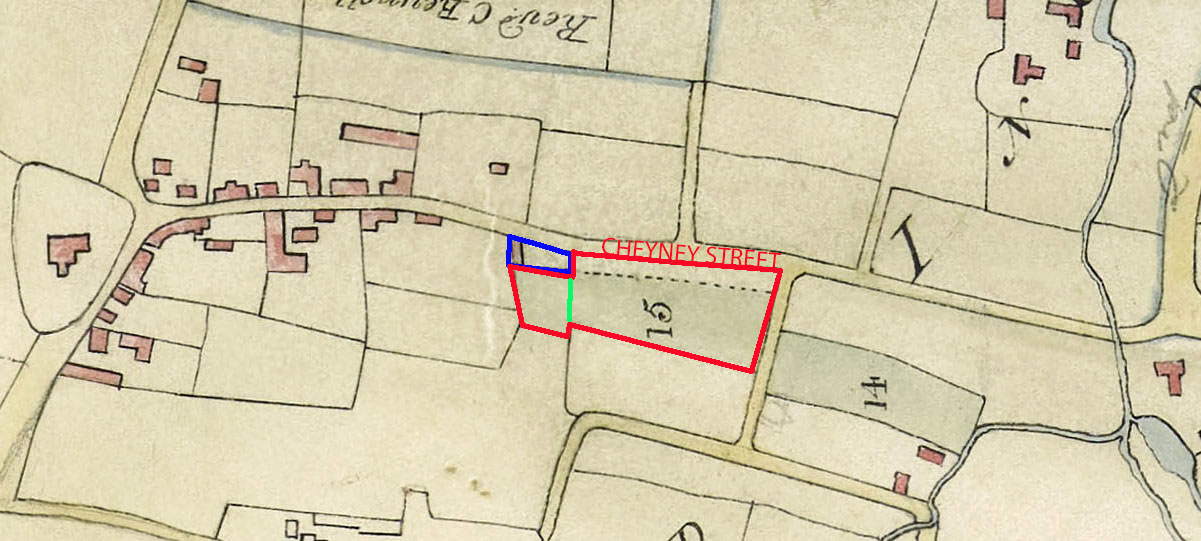
The original cottage with garden is outlined in blue. The adjoining land, shaded and numbered 15 is Cook's Close 1a 2r 27p, an old freehold inclosure allotted to the Earl of Hardwicke in exchange from St John's Cottage. The roadside strip of land was already in the ownership of Hardwicke. The full extent of Cook's Close after Enclosure is outlined in red. The description includes that the garden of Joseph Wright lies to the north and west. The land to the left of the green line was added as garden to Nos 22 & 24 at a later date.
Tithe Map 1839
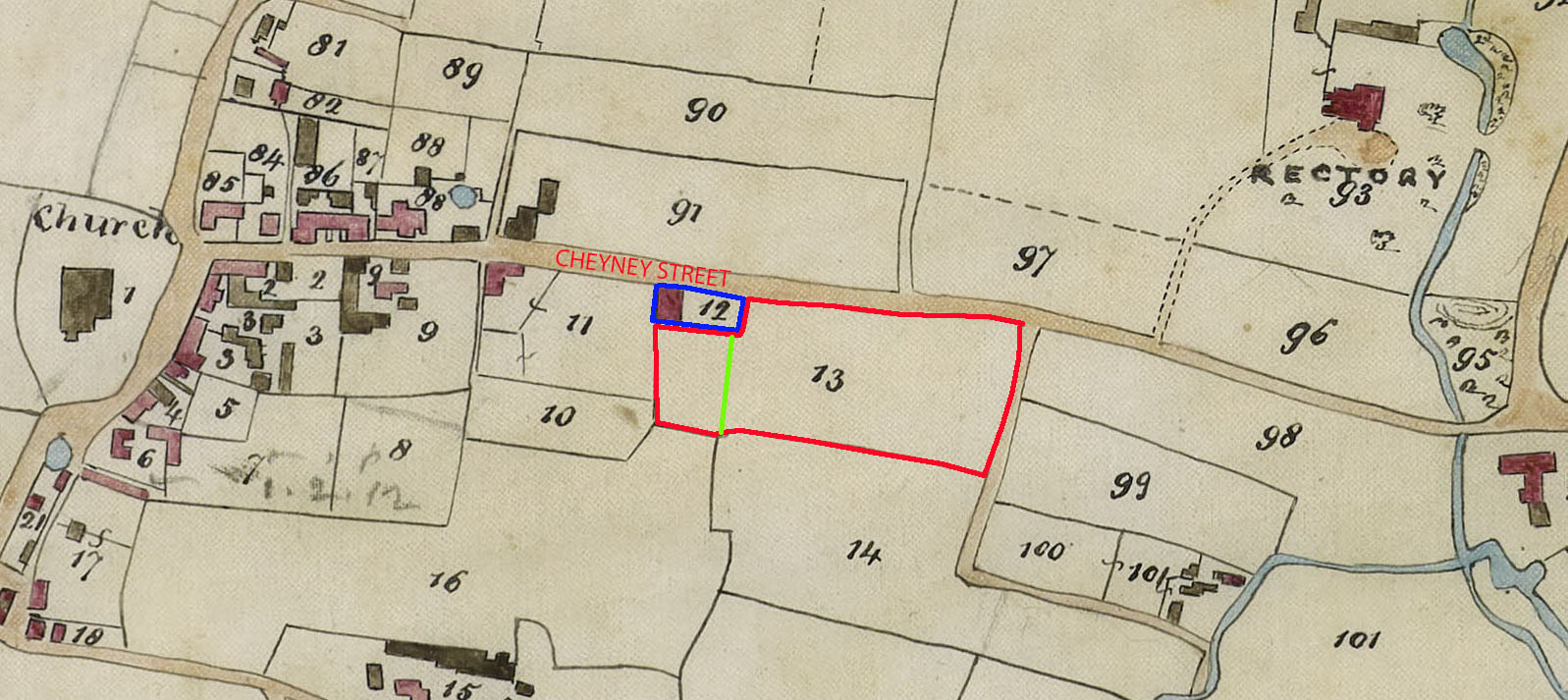
Plot 12 outlined in blue is 22 Cheyney Street. Owner and occupier Joseph Wright cottage and garden 17p. Outlined in red is the adjoining land, of which the owner is Earl of Hardwick and occupier Abraham Pearmain Cook's Close pasture 1a 3r 38p. The land to the left of the green line was added as garden to Nos 22 & 24 at a later date.
Click on any image below to view. Click again to enlarge. Drag to view entire image.
Photographs and Maps
Sale Particulars
Census Returns 1841 to 1939 Residents of No 24 Cheyney Street
Last Updated on May 5, 2025

